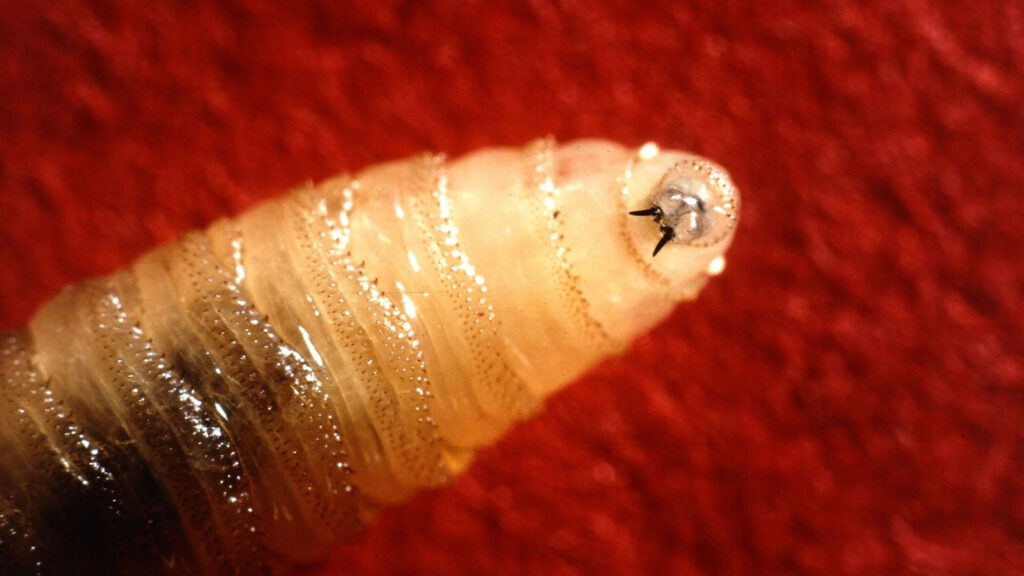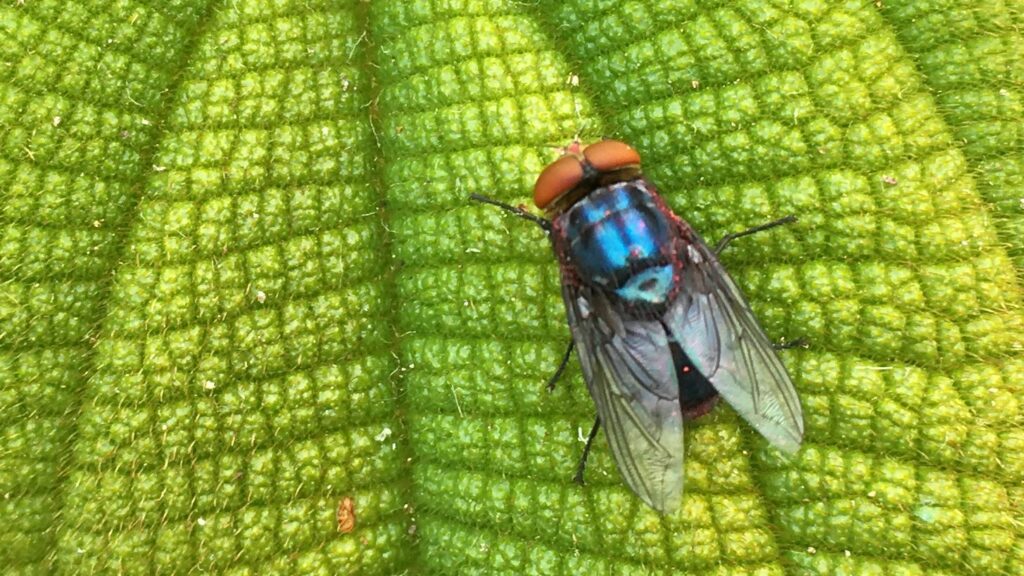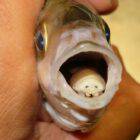What is a Screwworm?

Screwworms, scientifically known as Cochliomyia hominivorax, are a notorious species of parasitic flies belonging to the family Calliphoridae. These insects are renowned for their destructive impact on livestock and wildlife, as well as their ability to cause severe wounds and infections in their hosts.
From Larvae to Flies
The life cycle of screwworm flies encompasses several distinct stages, each crucial for their survival and reproductive success. It begins with the female screwworm fly seeking out a suitable host for oviposition. Using specialized sensory organs, the female identifies wounds, open sores, or natural body openings on warm-blooded animals, which serve as ideal sites for egg deposition.
Once a suitable host is found, the female screwworm fly deposits her eggs, usually in clusters, near the site of injury or infection. The eggs hatch within hours, giving rise to voracious larvae that immediately begin feeding on the host’s living tissue. The larvae possess mouthparts equipped with sharp hooks or spines, enabling them to burrow deep into the flesh of their host and extract nourishment.
Over the course of approximately five to seven days, the screwworm larvae undergo three distinct stages, during which they continue to feed and grow rapidly. As the larvae feed on the living tissue of their host, they cause deep, necrotic wounds that can rapidly escalate into severe infections if left untreated.
Following the larval stage, the mature larvae exit the host’s body and seek out suitable soil or substrate for pupation. Within the pupal case, metamorphosis occurs, culminating in the emergence of adult screwworm flies. Upon emerging, adult flies seek out mates to reproduce, perpetuating the cycle of infestation and spreading the parasitic threat to new hosts.
Screwworm flies typically measure around 8 to 12 millimeters in length and exhibit a metallic blue or green coloration, often with an iridescent sheen. Their wings are tinted with shades of orange and may feature three black stripes across the thorax, distinguishing them from other fly species.
The Parasitic Larvae
The screworm larva is a voracious and destructive parasite in its developmental stage. Upon hatching from eggs laid by adult screworm flies, the larvae immediately begin their parasitic lifecycle.
Screworm larvae are cylindrical, legless maggots with segmented bodies. They typically range in size from a few millimeters to over a centimeter in length, depending on their stage of development. The larvae possess distinctive spines or hooks along their body segments, which resemble the threads of a screw, hence the name “screwworm.”
The primary feeding behavior of screworm larvae involves burrowing into the flesh of their host animals. They are obligate parasites, meaning they rely entirely on live tissue for sustenance. Upon finding a suitable host, such as a wound or natural body opening, the larvae use their sharp mouthparts to penetrate the skin and feed on the living tissue beneath. This feeding activity can cause extensive damage and lead to secondary infections in the host.
As they grow, the larvae molt their outer exoskeletons to accommodate their increasing size. Once fully developed, the larvae pupate in the soil or other suitable substrates, where they undergo metamorphosis into adult flies. The entire life cycle, from egg to adult, typically takes two to three weeks to complete under optimal conditions.

Host Range and Impact
Screwworms exhibit a broad host range encompassing various warm-blooded animals, including livestock, wildlife, and occasionally humans. This adaptability contributes to their status as one of the most destructive parasitic pests, capable of causing significant economic losses and ecological disruptions.
Livestock such as cattle, sheep, goats, and pigs are frequent targets of screwworm infestations. The flies are attracted to wounds, either traumatic injuries or natural body openings, where they deposit their eggs. In livestock production systems, screwworm infestations can lead to reduced meat and milk production, impaired reproductive performance, and increased susceptibility to secondary infections. The economic consequences of screwworm outbreaks extend beyond individual animals to affect entire herds, resulting in substantial losses for farmers and ranchers.
In addition to domestic livestock, screwworms pose a significant threat to wildlife populations, particularly in regions where humans and wildlife coexist in close proximity. Deer, both captive and wild populations, are particularly susceptible to screwworm infestations. Infections can lead to debilitating injuries, loss of mobility, and heightened vulnerability to predation. In severe cases, screwworm infestations have contributed to declines in deer populations, exacerbating conservation challenges and disrupting ecosystem dynamics.
Screworms and Humans
While screwworm infestations primarily target animals, there have been occasional cases of human myiasis caused by Cochliomyia hominivorax. These incidents typically occur when humans are exposed to environments where screwworm flies are present, such as agricultural settings or areas with high populations of livestock or wildlife. Although human cases are relatively rare, they can result in painful and debilitating consequences if left untreated.
One notable case occurred in the mid-20th century, known as the “New World Screw-worm Program” in the United States. During this time, screwworm infestations posed a significant threat to livestock production, causing substantial economic losses and animal welfare concerns. In addition to its impact on agriculture, screwworms occasionally affected humans, particularly individuals working closely with livestock or in rural areas.
In 1958, a particularly severe outbreak occurred in Florida, where several cases of human myiasis were reported. One of the most infamous cases involved a young boy named Robert Davidson, who sustained a minor injury while playing in his family’s backyard. Unbeknownst to him, a screwworm fly had laid eggs in the wound, leading to a severe infestation of screwworm larvae. The larvae burrowed into the boy’s flesh, causing excruciating pain and tissue damage.
Control and Management Strategies
Over the years, scientists, veterinarians, and policymakers have developed and implemented a range of techniques aimed at reducing the prevalence of screwworms and preventing their spread.
Historically, chemical insecticides have been a primary tool for controlling screwworm populations. These insecticides are applied to livestock and wildlife hosts either through topical treatments, sprays, or dips. While chemical control can provide rapid knockdown of adult flies and larvae, it has limitations, including environmental concerns, potential toxicity to non-target organisms, and the risk of developing insecticide resistance in screwworm populations.
Sterile Insect Technique (SIT) is a biological control method that involves mass-rearing and sterilizing male screwworm flies using irradiation. These sterile males are then released into the wild to mate with wild females, resulting in sterile matings and reduced reproductive success. SIT has proven to be an effective and environmentally friendly approach for suppressing screwworm populations in various regions, including North America and parts of South America. However, SIT requires significant infrastructure, resources, and coordination to implement effectively.
Biological control involves the introduction or augmentation of natural enemies to suppress pest populations. Several natural enemies of screwworms, including parasitic wasps and predatory insects, have been investigated as potential biological control agents. These natural enemies can help reduce screwworm populations through parasitism or predation, offering a sustainable and environmentally friendly alternative to chemical control methods.










